Billiard Cloth
The 'Baize' is really Pure Wool Cloth
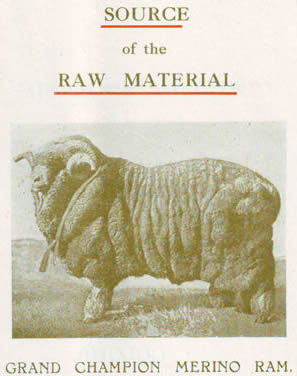
When you hear or read the cloth that
covers the slate and cushions of a Snooker (Billiard) table
described as BAIZE you can almost hear the sharp intake of breath
in Stroud (West of England - Strachan) and Pudsey (Hainsworth)
where the last mills in the UK that produce Billiard / Snooker
cloth are based. Why the intake of breath - well baize is a wool
/cotton mix material used for covering card tables and notice
boards, whereas the cloth used on Snooker tables is a specialist
quality pure wool material with a raised nap and is a much more
costly engineered product. A far superior material than baize!
The UK Billiards & Snooker cloth, unlike the worsted cloth
used on European and USA style Billiard and Pool tables has a nap.
One theory for this was that the cloth used for the cloaks worn by
the drivers of horse drawn coaches had a nap that ran from the
shoulders to the bottom of the cape. This encourage the rain to
flow off the cape which would have kept the coachman drier for
longer. This theory speculates that the same cloth used for the
coachmen's capes, which according to the theory was also green in
colour proved to be acceptable for UK style Billiard tables. Mind
you the other theory as to why the cloth is green relates to the
Billiards being played on a lawn on the ground, so when the game
was brought indoors on to a table the cloth covering the table was
the same colour as the 'grass'!
In the early days the finest wool was imported from Germany - in
an article recording 'A Visit to Hunts & Co's' mills it reports
- "It would seem, then, that the fineness of German wool is due
not to any peculiarity in type of breeding or feeding of the sheep,
but simply to the fact that the animals are under fed".
However as a result of WW1 it was the Merino sheep's fleeces from
Australia that became the source of the fine quality wool required
for Billiard cloth.
In the 'old' Thurston ledgers there are many references to 'Best
West of England' cloth an example is shown below and you will see
from the date that Thurston have been buying Billiard
cloth from the 'West of England ' mills based in Stroud for over
120 years. Now the cloth used on the World Championship tables is
branded as 'Strachan' (pronounce by the English as "strawns"!!)
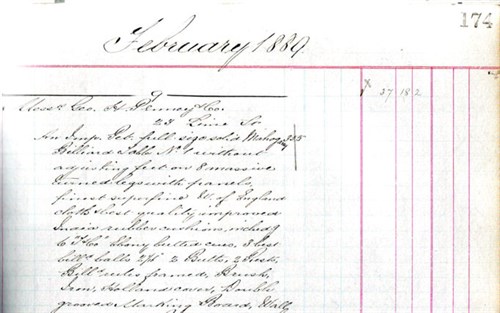
An entry from the Thurston English
Order Book dated February 1889 - which, on the fifth line of
description says "finest superfine W. of England cloths"
In our collection we have a copy of a
booklet issued by Hunt & Winterbotham which was circulated by
Orme & Sons Ltd ( Link to Orme & Sons history) in 1924 (on
one of the copies Mr. E. A. Clare founder of the Liverpool firm had
written a dated noted about Orme's involvement). The information in
that booklet is still relevant to-day so we have transcribed it
below :-
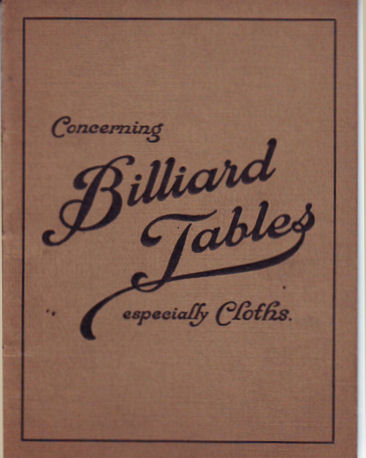
Front Copy of
Booklet
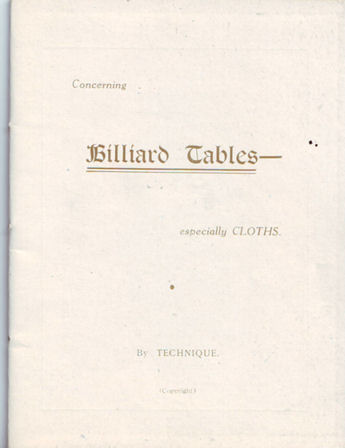
Title Page -
'Concerning - Billiard Tables- especially CLOTHS'
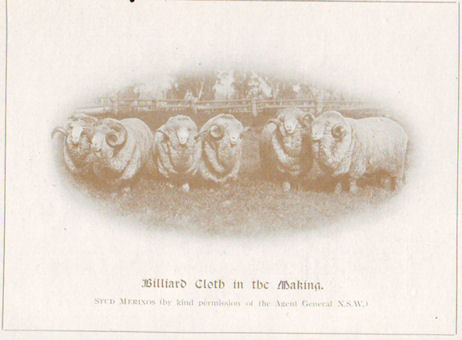
Before the
written section starts this picture of 'Stud Merino' is
shown
THERE are many
points about a Billiard Table, which, provided the timber is sound
and well seasoned, do not greatly matter beyond the question of art
and style. There are, however, three points, viz : the slates, the
cushions, and the cloth, the perfection of which is absolutely
essential if the game is to be played in any degree
scientifically.
Of theses, three the slates may be trusted to
take care of themselves ; so may the cushions, provided they are
properly treated by the players, and that the temperature of the
Billiard Room is suitable and kept reasonably equable. But the
cloth is another matter, and from the very nature of its
construction demands regular care and attention of an intelligent
kind. The more the true nature of a Billiard Cloth is under. stood
the easier it is to keep it in just that perfection of condition
which ensures the perfect running of a ball, and without which no
decent game can be played.
It may be said at the outset that there is no
material, either animal or vegetable, which can provide so suitable
a surface over which a ball can travel with that truth, steadiness,
and quietness that the stroke demands, as does a fine woollen
cloth. It is because so few people interested in Billiards really
understand a cloth, that it gets so frequently blamed for troubles
for which it is in no way responsible. And yet, given a little
thought, it is possible so to understand it, or, to use an
expressive French term, so to "soigner" the table that the pleasure
and accuracy of the game are vastly increased.
A Billiard Cloth is not a piece of leather or
linoleum ! It is a delicately constructed fabric made on strictly
scientific principles, and the care of a cloth consists in the
continuance, in a minor degree, of just those principles and
processes which have been involved in the later stages of its
manufacture.
Every little thread in a bed length of
Billiard Cloth,-and there are some fifteen thousand, from the baulk
end to the top of the table.-is constructed of a mass of tiny
fibres, each of which in its turn is built up of delicate
microscopic cells, each hitting into, and overlapping the. other,
very much in appearance like the scales of a fish.
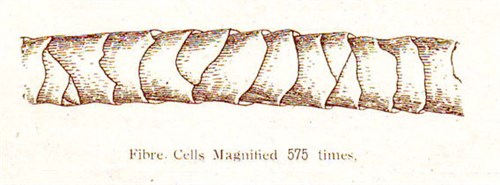
Now it is the
intelligent consideration for, and proper treatment of these fibres
which really matter in the care of a Billiard Cloth. Their
usefulness and perfection can easily be destroyed. They can be
bruised out of all recognition by hard, sudden pressure or blows,
-they can be torn and scratched by unsuitable and unreasonable
brushing -they can be scorched and burnt by a too hot iron till
their very nature and tenacity are destroyed, and they can be
seriously affected by continued damp. But given care and correct
treatment these little fibres will play their, part in the great
game of Billiards to the entire satisfaction of its most critical
exponent.
To come a little closer to detail. Beneath
the cloth is the slate-a surface hard and unyielding. Above the
cloth is the ball-with a consistency and substance of even still
greater resistance. I do not suppose that one player in a thousand
realises what he does when he throws a ball on to the table with a
fairly sharp concussion. The pressure which the cloth receives from
the impact between the unyielding surfaces of the ball and the
slate is sufficient to crush and bruise the fibre cells, thus
lessening their efficiency and usefulness, and incidentally
removing some of the nap from the surface, of the cloth.
The same thing is possible with a hard masse
shot or any similar or violent stroke. It must be remembered that
although the surface of a ball is round, yet the actual point of
contact with the cloth, or with an other ball, is infinitesimally
small, thus, having really a "cutting" effect, and given sufficient
impact will even cut clean through the cloth.
I have often heard it stated that these
little bare or grounded places which I have described as being left
on a cloth after some sharp concussion or impact, are caused by
moths. I have only to add that such an accusation is an unkind
libel on the habits of an insect which already has enough sins
lying at its door without including Billiard Cloths !
This liability of a cloth to " cut " under
extreme pressure is better understood when it is remembered at what
a great tension it is stretched over a slate. It is,or should be,
"as tight as a drum", and there. fore just in the condition to
render it liable to injury from any outside cause. If it were
merely lying normal, or at rest, as for in. stance like an ordinary
dining-table cloth,this liability would be very much
reduced.
In this connection I have purposely said
nothing as to the very common trouble of the shaving off of the nap
of the cloth by a cue tip, especially if the tip is ragged or
rough. Untold damage can very quickly be done to a new cloth in
this way, and it is the result either of gross carelessness or an
entire misconception "of how the game should he played.
The two methods adopted for keeping a cloth
in suitable condition for play are brushing and ironing, and the points
I have referred to in the first paragraph are intimately connected
with these two operations. Both of them, as I have said are the
continuation in a minor degree of processes of manufacture through
which the cloth passed in its final stages.
First as to brushing. I have seen
markers brushing a cloth hard against the nap (i.e. from the top of
the table towards the baulk end) or scrubbing it round and round
like a woman scrubs a stone floor. Both are fatal to the condition
of the cloth and in fact a new cloth may be so injured in this way
as to make it impossible to again "Set" the surface
properly.
The table should be brushed the running way
of the nap of the cloth, i.e. from the "D" end to the other, and in
doing so you merely follow the lines on which the manufacturer
produced the original nap on its surface. (It sometimes happens
that for some reason the cloth is reversed, the " D " end being
changed to the top of the table. In that case of course the above
remarks would not apply, as the cloth should then be brushed from
the top of the table to the baulk end).
Secondly as to ironing. This again is a minor
reproduction of a manufacturing process, viz : pressing.
An overheated iron has a directly injurious
effect on those little fibre cells which are the very life of the
cloth. It drives out of them the natural, or absorbed moisture
which they contain and which are necessary to their elasticity,
suppleness, and brightness,-leaving them dry and brittle, and far
less capable of standing the strain of play and brushing to which
they are continually subjected.
It is a truism that a really fine cloth "feeds" and improves
with age, and though that is an expression which may perhaps be a
little difficult to analyse scientifically, it is nevertheless the
result of experienced observation, and is closely connected with
the condition of the fibre cells. Excessive heat would entirely
prevent this and it is far better to go over a cloth three or four
times with a moderately heated iron, than once only with an iron so
hot as to produce the undesirable effect I have suggested.
There is at Dover a famous bronze Gun, cast
in Utrecht in 1544, and presented to Queen Elizabeth by the States
of Holland It bears an inscription in low Flemish which has been
translated, rather freely, in several ways. One version however,
reads - Charge me well, and sponge me clean, And I'll throw a ball
to Calais Green."
The point is that the gun undertook to do
certain work on certain conditions. So with a well made and good
quality Billiard Cloth. If properly and intelligently cared for it
will-do the work and play the part it has undertaken to do, and
those interested in its perfection and condition will find it will
well repay the trouble and thought given to it.
It would not be in the interests of the maker
of a Billiard Table that the cloth he supplies should last for ever
! But it is distinctly in the interests of his reputation that
those who purchase his tables should get the very best possible
value out of them, and it is solely with the object of assisting
them to do this that the foregoing remarks are offered.
So the booklet
ends.
However the production of woollen cloth from that
area goes back many more years than that. In "The History Of
Strachan & Co" written by Esther A. L. Moir in 1955, she writes
that 'it is abundantly clear that by the thirteenth century cloth
making was being carried out extensively here'. From those early
days all types of woven woollen material was produced from army
dress material to suiting as well as Billiard Cloth. Now the Stroud
mills specialise in Billiard Cloth & Tennis Ball Cloth.
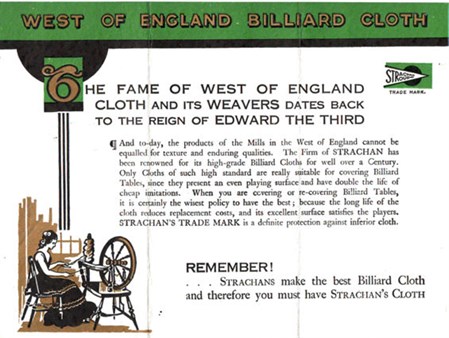
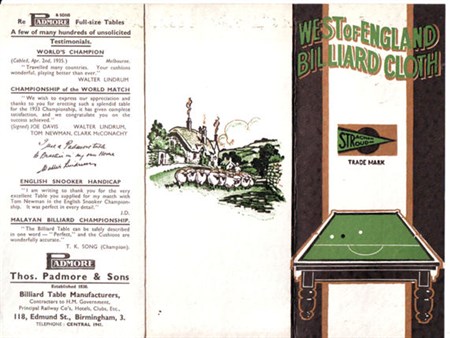
The above is a
two side sales leaflet circulated by Thos Padmore & Sons
circa 1940
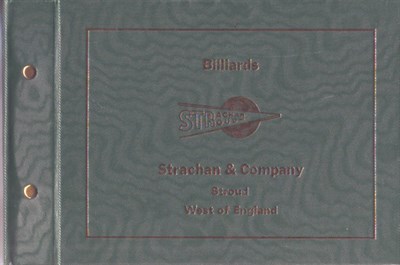
Front cover from
a cloth sample booklet sent out by Strachan's in the
1980's
Naturally our interest is in the Billiard Cloth production and
certainly the production of cloth for Billiard tables also goes
back through the centuries. Hunt & Winterbotham dates from the
1860's.
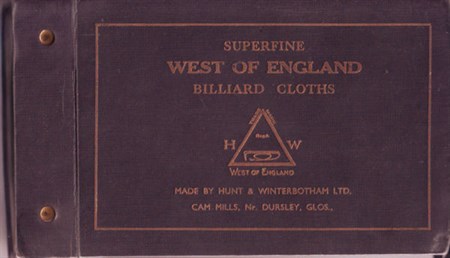
Billiard cloth
sample booklet issued by Hunt & Winterbotham circa
1950
In the 1920's Strachan, Playne and Hunt &
Winterbotham came together and traded as Winterbotham, Strachan
& Playne. This business later became a division of Illingworth
Morris a UK textile group and subsequently in 1990 a division of
Milliken Industries whose parent company in the USA enjoys a
similar history dating back to 1865.
A copy of a competition
sheet issued by E.A. Clare & Son Ltd. Circa 1940
which shows an old West of England trade mark with a 1646 date
within it. It is we believe associated with Hunt &
Winterbotham.
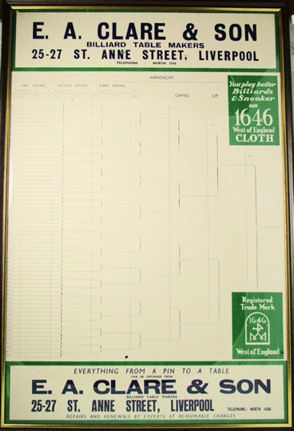
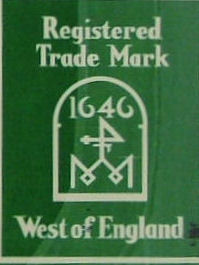
close up of the
Trade Mark
Strachan have provided some interesting 'old'
pictures not only showing how production was carried out but also
historical pictures of the mill building.
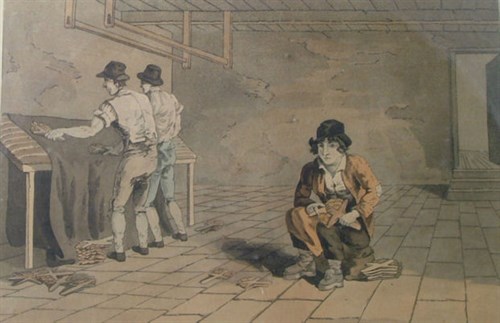
This water colour painting shows the
men at the bench hand teazeling the cloth with the boy fitting new
teazels to the tools.
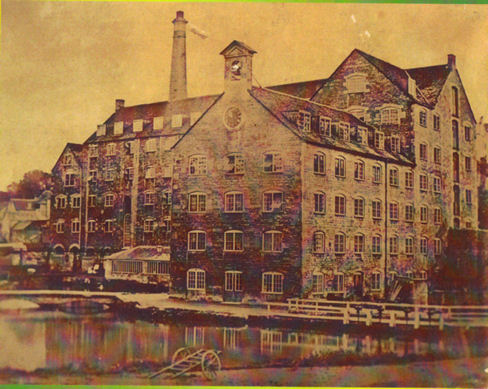
Lodgemore Mill before
1871 Fire
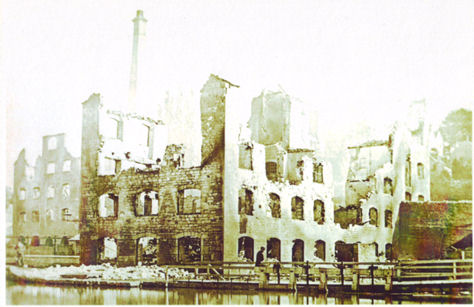
Lodgemore Mill after
1871 Fire
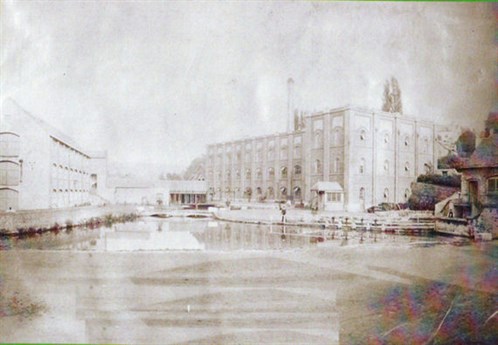
Lodgemore Mill
rebuilt after 1871 fire
The following
pictures showing production are from a period just after the WWII
and show the old machinery and working methods.
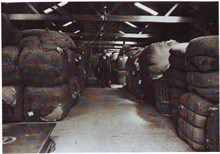
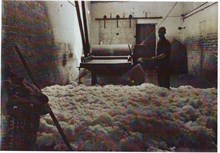
The first picture
shows the Bales of raw wool as the are received from Australia and
are stored until required. The second picture is 'oiling the
wool' - Oil is applied to lubricate the fibres and aid the blendin,
carding and spinning.
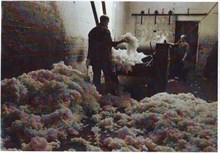
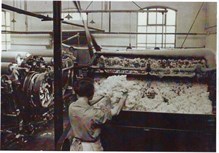
The first picture
shows the blending when the bales are opened and mixed. The second
picture is the carding - this seperates the wool fibers into a form
suitable for spinning into yarn.
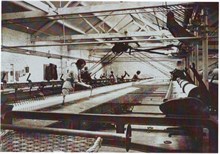
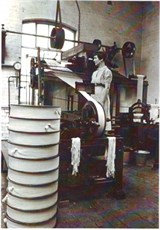
The first picture
shows 'Mule' spinning to produce the yarn. The second picture is
'section warping' - here the yarn is built into packages for
presenting to the loom for weaving.
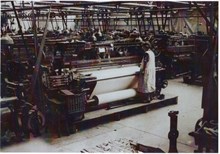
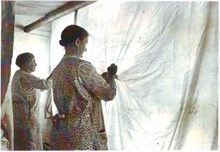
The first picture
is the weaving floor. Shuttle looms insert the weft threads and
creates the 'grieg' cloth which is in the 'white'. The second
picture shows 'mending /burling the cloth. The cloth is inspected
and knots removed and faults in the weave corrected.
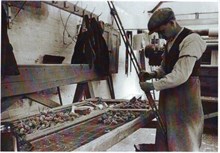
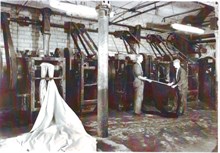
The first picture
shows teazel setting. A teazel is a type of thistle head and is set
into a frame. The frames are fixed into a raising machine which
will creat the nap, sheen and lustre on Billiard Cloth. The second
picture is 'Fulling' - this process combines heat, moisture and
friction to shrink the and felt the cloth.
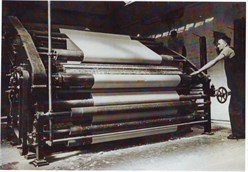
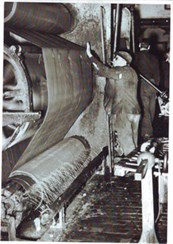
The first picture
is a Teazel gig which is used to lay the nap.The second picture
shows the Billiard cloth being 'Wet Brushed'. Both Processes
are used to lift and lay the directional nap on Billiard
cloth
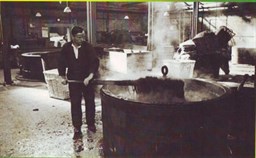
Billiard cloth in
the dyeing room
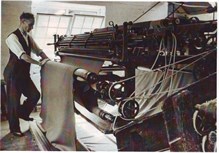
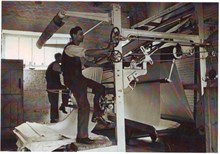
The first picture
shows billiard cloth being 'sheared', this process ensures a
uniform length to the nap and adds lustre to the cloth. The second
process show the cloth being dried.
Strachan West of
England cloth uses only the finest Merino wools from Australia
carefully selected according to very precise specification and the
woven"greige" (the rough cloth) is put through a series of
complicated specialised processes such as "raising" or "teazeling".
To raise the face of the cloth and give a direction or "nap" and
"milling" which provides the body or weight. After these processes
the cloth is transformed into a highly engineered fine billiard
cloth featuring the napped lustrous characteristic of Strachan West
of England.
Strachan West of England cloth has been chosen by
the Professional Billiards & Snooker Association for use at all
major snooker and billiard tournaments, including the prestigious
World Championships since 1980
Acknowledgements - Strachan West of England
for providing much historical information as well as many of the
pictures used in the article.
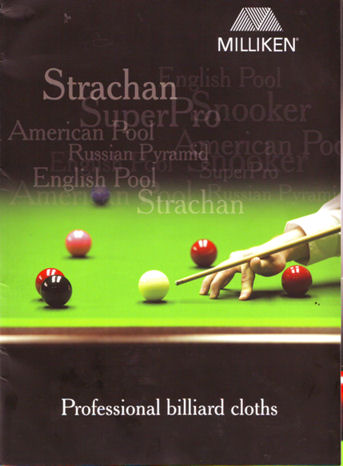
The story of the West of England
Billiard Cloth continues :-
Textile manufacturer (Strachan Snooker &
Pool Cloth) returns to UK
ownership
In
2011, twenty years after it was bought by US based Milliken &
Company, the Stroud textile business Milliken Woollen Speciality
Products (Strachan) has proudly returned to British
ownership.

The
business has been christened WSP Textiles Ltd, with three senior
members of the management team joining a new board of
directors.
The
former Milliken WSP management team who have seats on the board are
the new chief executive David Smith, sales director Duncan Kettell
and manufacturing director Malcolm Fallows.
The
acquisition was arranged by Vespa Capital LLP, a private equity
firm that helps management teams acquire and develop the businesses
they manage.
The
original company had made cloth since the 13th century
and the WSP acronym recognises the founding mill owners, Messrs
Winterbotham, Strachan and Playne.
Today
the Strachan brand dominates the snooker market while Playne tennis
ball cloth can be found on Dunlop, Wilson, Head, Tretorn and
Babolat tennis balls used at many tournaments including Wimbledon
and the French Open.

The famous Strachan (West of England) cloth has now been used at
all WPBSA / World Snooker events, including the World
Championships, since 1980 and ofers all levels of player the
ultimate playing surface. All Strachan snooker & English pool
cloths use 100% wool and are made in a very traditional
way using many ancient techniques whist blending this with todays
modern quality standards.
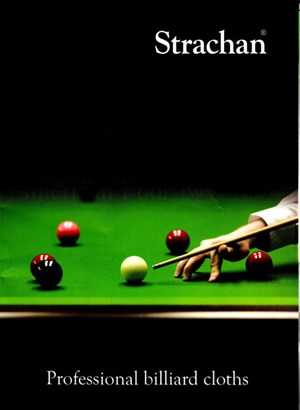
Strachan 2012 Snooker Cloth brochure
….......................................
Thurston offer a full
service for the recovering of Snooker, Billiard, Pool tables and
also for Bagatelle and Bar Billiard Tables using both Strachan West
of England cloth and Hainsworth cloth. Thurston also offer a
comprehensive maintenance contract and are able to supply all the
accessories for Snooker, Billiards & Pool.
Just call -
44(0)151 482 2700 or visit www.thurston.co.uk
© E.A. Clare & Son Ltd.
2018. © Peter N. Clare 2018
Reproduction of this article allowed only with the permission from
E.A. Clare & Son Ltd.

